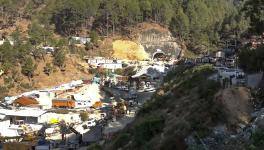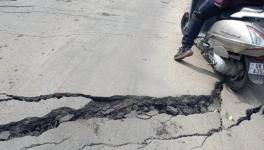New Definition of Forest Foreshadows End of Forests in Uttarkhand
The COVID-19 pandemic has already infected more than 100 million people globally. Scientists say the pandemic could have been much better contained if forests had not been depleted on a large scale. But has India learned this lesson from the pandemic? If the experience of the state of Uttarakhand, which once boasted of a 70% forest cover is anything to go by, the learning curve has been flat, if not in the negative territory.
Data released by the Uttarakhand Forest Department shows the state has lost 50,000 hectares of forest land to ‘development activities’ in the last twenty years. In terms of losses due to ‘development’ activities, the most forest cover—8,760 hectares—was lost due to mining. Road construction has taken away another 7,539 hectares, and 2,332 hectares were lost to power distribution lines. Another 2,295 was lost to hydropower projects.
The negative figures do not stop here: A whopping 10,649.11 hectares of forest have been lost due to human encroachment, and 44,518 hectares to forest fires.
Moreover, two months ago, a decision was taken to chop a large swathe of ancient sal trees that cover 10 hectares of reserve forest at the Rajaji Tiger Reserve. This is being axed to make way for the extension of the Delhi-Dehradun highway. This was being done, road transport officials explain, to reduce the driving time between Ganeshpur and Mohund from 24 to 12 minutes.
If such large-scale devastation of forests were not bad enough, the state government has now come up with a new definition of forests to pave the way for further acquisition of forest land for industrial and mining activities.
According to the Uttarakhand government’s new definition, a “deemed forest” is “a land patch of 10 hectare or above with 60 per cent canopy density and 75 per cent native plant species” other than, of course, the existing forests that have already been notified.
State forest minister Harak Singh Rawat has said the new definition of what is a forest will “help safeguard the forests and give [a good] pace to development projects”.
Interestingly, Uttarakhand is the first state to have come up with a definition of forests.
The state government has spelled out these details to be able to divert land without having to seek the prior approval of the Ministry of Environment and Forests (MoEF).
Abhijay Negi, an environmental lawyer who has challenged this definition in the Nainital High Court says, “This [definition] was brought in to bypass the Forest Conservation Act, (FCA) 1980, and the National Wildlife Act.”
Negi expresses regret that the task of defining forests has been handed over to anti-conservationists who are willing to overlook the fact that less dense forests and meadows also need to be conserved. “Nor does this limited definition give consideration to the vast bio-diversity that is present in our less dense forests,” he says.
Why should this can of worms have been opened in the middle of a pandemic? It is believed that this is in response to signals from the MoEF, which has also been keen to get rid of prevailing environmental norms.
This abdication of its responsibility towards environment-protection can be garnered from a letter issued by the MoEF on 14 November 2019, which outlined that every state must arrive at its definition of forest cover. The Centre would no longer be concerned with this matter since the criteria finalised by the states would no longer be subject to the approval of the environment ministry.
Dr. S Lele, a distinguished fellow at the Centre of Environment and Development, is appalled by the contradictory stand adopted by the MoEF. Lele said, “In 2017, the Forest Survey of India 2017 [a body under the MoEF] spelled out the definition of forest as one hectare or more of land with a 10 percent canopy cover.”
This definition would have made it practically impossible to get any land denotified, thereby raising the shackles of the industrial and mining lobby.
The impetus to define forests goes back to a 1996 Supreme Court ruling in the TN Godavarman Thirumulpad case in Tamil Nadu which began as a petition to stop illegal felling of timber in the Niligiri hills, but it was soon extended to look into the issue of forests as a whole.
The Supreme Court had then ordered that all mining and felling of trees be stopped in forest areas. It also excluded the lower courts from hearing matters relating to the implementation of the FCA, making it the sole administrator of the law when it came to forest matters.
The need to define forests goes back to this ruling because the Supreme Court had asked states to identify, demarcate and notify forest areas which they have failed to do over all these years.
Prof Vikram Soni, physicist and environmentalist activist pointed out that the Godavarman judgment was used when his NGO, Citizens for Preservation of Quarries and Lake Wilderness, made a determined effort to preserve the ridge forest in Delhi. The Delhi Development Authority had wanted to build a road to facilitate the construction of thirteen high-end hotels.
“We managed to save 223 ha of pristine Ridge forest by pointing out that the thorny kikar vegetation that inhabits this area is very much a forest,” says Soni.
The Indian Forest Act, 1927, which the British implemented, had also failed to define forests although forest areas were legally notified under the three brackets of “reserve”, “protected” and “panchayat grazing land”. Former prime minister, the late Indira Gandhi, had pushed through the FCA, 1980, making central government approval mandatory before forest land could be diverted for non-forest use.
The government is washing its hands of all these statutory frameworks. By lobbying the ball into the court of state governments, the MoEF knows full well they will no longer have to face the music on tricky issues of biodiversity conservation, land acquisition, and implementation of tribal rights.
How do you measure a forest? Negi says there are clear indicators that had been used earlier to specify forest area. “In the past, pillars had been placed at a distance of 100 meters to demarcate a forest area. Unfortunately, today, the forest department has a very lackadaisical approach to this issue as do state wildlife boards, which have been filled with members who are not committed to forest preservation,” Negi says.
Lokesh Ohri, a heritage conservationist and founder of “Been There Doon That” believes that Uttarakhand had earlier built up a reputation for environmental struggles.
“Look at the massive protests in our state, be it the Chipko movement or against the construction of Tehri Dam. Today we are witnessing a complete dilution of the institutional hold over resources. People express disillusionment in private conversations, but at present there is no leadership to pick up the banner against this environmental devastation,” says Ohri.
“Doing away with Environmental Impact Assessment studies has also left NGOs and the public with little time to organise protests,” Ohri says.
A corollary to the massive ongoing deforestation is the large allocation of CAMPA funds that Uttarakhand has been getting. In 2019, the Union Minister of Environment and Forests, Prakash Javadekar, handed over a cheque of Rs.2,675 crore to Rawat. This was given to do extensive plantation works along the banks of the Rispana, Bindal, and Song rivers, which pass through the city of Dehradun.
Reenu Paul, a conservation activist, says, “Very little plantation work is done on the ground and the excuse trotted out is that these new plantations have got burnt by successive forest fires.”
What has surprised local communities is the latest proposal of the Uttarakhand government to divert the CAMPA funds that their state has received to grow forests in other states, as they have been left with no land to meet the compulsory afforestation targets.
In one such proposal, the state forest department has sought land from the Uttar Pradesh government instead of the trees that will be axed for the construction of the 5040 MW multi-purpose Pancheshwar Dam project between India and Nepal.
“This will only further dilute accountability,” says Paul.
Recent research has warned of the alarming pace at which natural forests across India are disappearing, including the serious decline in core forest areas. Three recent scientific reports published in Applied Geography and two in Ecological Indicators unambiguously say that the Eastern Ghats alone has lost nearly 16% of its forest area in a century, and point to the steady decline of forests in the lower heights of the Himalayas.
Dr. Ravi Chopra strikes a pessimistic note when he says: “We will wake up when disasters come hurtling down one after another. We are forgetting that, given its geography, Uttarakhand remains one of the most vulnerable states in the country.”
The author is a freelance journalist. The views are personal.
Get the latest reports & analysis with people's perspective on Protests, movements & deep analytical videos, discussions of the current affairs in your Telegram app. Subscribe to NewsClick's Telegram channel & get Real-Time updates on stories, as they get published on our website.
























